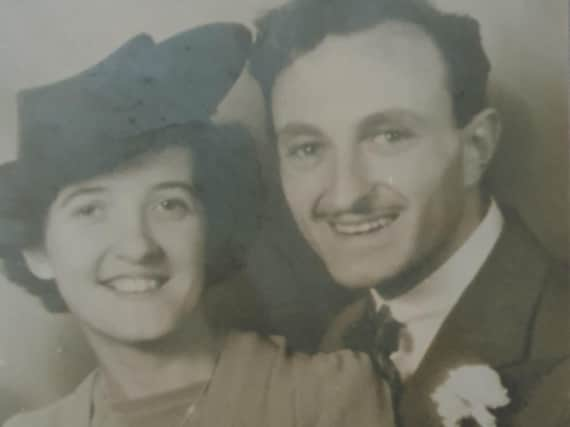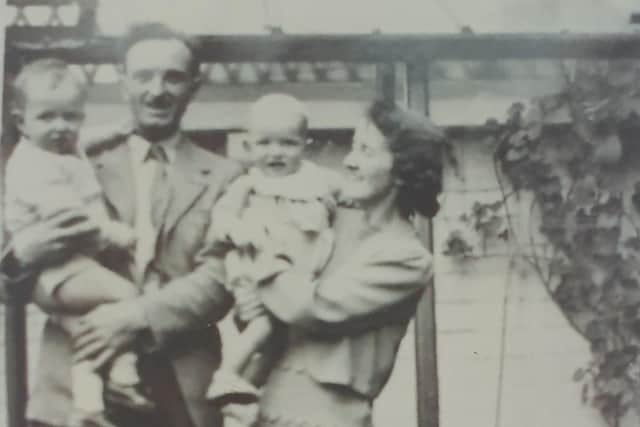My Father's War: How the letters to his love in Blackpool led to marriage for Kenneth Bevan


Dad arrived in Gibraltar on June 2 1942, having embarked from Scotland on a troopship. The temperature on this Mediterranean land mass reaches an average of 26 degrees at this time of year and is pleasant all the year round (although there will be snow flurries on Christmas day of this year!). In common with the vast majority of Britons at this time he has never been abroad. Although he is naturally anxious about what lies in store for him, he is also exhilarated by the experience.
Gibraltar (or `Gib` as he and his RAF colleagues refer to it) occupied an important position. This tiny colony on the most southerly tip of neutral Spain allowed for control over all shipping coming into the Mediterranean from the Atlantic Ocean and vice versa. On the Friday night of the week following his arrival, a given signal, all of the guns suddenly open fire as part of a test run which is repeated each week. At the same time all the searchlights on Gibraltar burst into life – surely a spectacle to rival The Illuminations now sadly redundant in Dad’s hometown!
The Eagle


Advertisement
Hide AdAdvertisement
Hide AdThe hangars at New Camp airport were busier than usual on the morning of 19 July 1942. The sweating aircraft fitters in dad’s unit were all stripped to the waist as they worked on assembling Spitfire components. These were delivered in crates by three freighters which left England on July 2 and arrived at Gibraltar twelve days later. Time was running short. The partly constructed planes had to be put aboard the Eagle aircraft carrier which was waiting in the nearby harbour. It was due to leave port on July 20 with an escort of seven ships, only three of which survived the war. The convoy was bound for the island of Malta and this particular run was known as Operation Insect.
Malta commanded a strategic position in the Mediterranean and is vitally important to the Allies. The small island was well placed as a springboard from which they could attack enemy ships transporting supplies from Europe to help in the battle for North Africa. The next day, half of the RAF unit engaged in partly assembling the planes wen t aboard the Eagle and complete the process at sea. The planes were then bused to strengthen the vital aircraft resources that were defending the island from attack. During the evening on July 20, dad, together with half the men in his unit, boarded the Eagle to start the task of completing the assembly of the thirty-two planes. The planes were due to take off the next day when the convoy had hopefully completed half the 1100-mile journey to Malta. The tension mounted as the convoy enters hostile waters and the nearer they got to their target area the greater the risk from enemy action. With the the assembly task completed, the weary men rest next to their planes in the giant hangar. All of a sudden, the ship, all 668 feet of her, slewed violently to one side, scattering tools and loose components all over the place. The Eagle had been attacked by a salvo of four torpedoes launched by an Italian submarine, which was later be identified as the Dandolo. By good fortune, or by virtue of the skill of the crew on the bridge, the torpedoes missed their target. Years after the war dad would comment that he could not believe that a ship of that size, loaded down with a full complement of men and aircraft, could move so quickly.
Algeria
By November The North African campaign was approaching a crucial stage. Dad, who had recently been promoted to leading aircraftman, had been posted to Algeria and arrived at a base called Maison Blanche (later to be re-named El Karash). This was a large maintenance, transport and air base about five miles from the city of Algiers. Although the Germans and Italians had been booted out of the whole of North Africa it was essential to maintain a presence against the possibility of renewed interest by the Axis powers. He had been allocated to No:144 Maintenance Unit to which he was be attached for the rest of the war.
Back in England compulsory conscription for women had been introduced. In practice that meant either joining the armed forces or carrying out work which furthered the war effort. My mother had tried to join the WAAFs but was turned down because of a damaged ear drum, the result of a botched operation to remove her tonsils. She started work as a shorthand typist for the firm of Vickers, who manufactured Wellington bombers. They had a large factory at Squires Gate and several other premises in the town specialising in making specific aircraft components. She still lived in the boarding house run by her mother and aunt. The correspondence which underpinned their developing romance continued.
Victory in sight
Advertisement
Hide AdAdvertisement
Hide AdThe war dragged on. June 6 1944 - D-Day, the Allies launched a massive attack on the north French coast at Normandy, reclaiming land occupied by the Germans for the last five years. In August of that year a further Allied invasion took place on the south coast of France. From then on, the Axis powers were living on borrowed time as the drive towards the centre of Germany commenced. Allied troops were also fighting their way up the spine of Italy formed by the Apennine mountains, the Americans on the right and the Allied 8th Army on the left. Dad’s brother Jack joins the action in Italy in summer of that year. He was responsible for several field guns attacking German positions. Eventually, in the early spring of 1945, the Germans retreated from the heavily fortified Gothic line stretching from west to east across northern Italy. By late April they are in full flight, the Allies in hot pursuit. The war in Europe is now all over bar the shouting. At long last this awful war is at an end.
Aftermath
On Tuesday January 16 1946, dad walked through the gates of No: 101 Personnel Dispatch Centre at Kirkham. A free man after five years serving his country. In late 1945 he was released under a special scheme to speed up the return to civilian work of men skilled in occupations vital to Britain’s recovery. He travelled from Algeria to Italy on his way home, pausing to visit the ruins of Pompei and to buy a pretty cameo necklace as a present for my mother. He travelled back by troopship from Naples and was posted on November 12 to RAF Pocklington in the East Riding of Yorkshire. This was a bomber station during the war. Doubtless his skills were put to good use during the two months that he served there.
Blackpool had survived the war but not totally unscathed. Despite the presence of the Vickers aircraft factory and the thousands of military personnel in training in the town there was remarkably little attention from the Luftwaffe. Perhaps this was because there were richer pickings in Liverpool, the largest port on the west coast. The city suffered terribly My mother remembered seeing the red glow of Liverpool on fire, clearly visible from Blackpool some 40 miles away. Seven people were killed and 14 were injured in Seed Street following a solitary attack on Blackpool North railway station in September 1940. The following summer there were 18 fatalities and 39 injuries when two allied aircraft crashed above the town, scattering debris and burning fuel over Central Station. The small fishing port of Fleetwood, lost numerous fishing boats from enemy action at sea. But it was all over. There were tumultuous celebrations throughout the town on VE day with bonfires and street parties.
On March 6 1946, just seven weeks after my fathers’ return to civilian life, he married the woman with whom he had corresponded for over four years. They became engaged soon after his return to Britain. The wedding took place at All Saints Church in Blackpool. A head and shoulders wedding photograph shows a fit, handsome man who bore a remarkable resemblance to the late film star David Niven. His new wife was pretty, slim and elegant and was wearing her cameo brooch. A full shot of the wedding party echoed the austerity of the period. The men are all dressed in heavy, shapeless clothes, my father wearing the ‘demob’ suit that was issued to him on leaving the RAF. Apparently the trousers had moth holes! My mother, however, looked chic in a smart hand-made suit and hat. My grandmother and Aunty Martha hadbeen saving their clothing coupons for a long time to pay for the outfit. Despite all the uncertainties and difficulties they came through it all. And thenthe future beckoned.
Comment Guidelines
National World encourages reader discussion on our stories. User feedback, insights and back-and-forth exchanges add a rich layer of context to reporting. Please review our Community Guidelines before commenting.